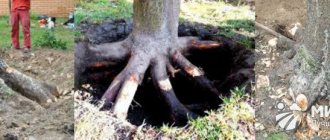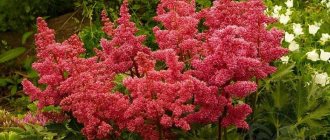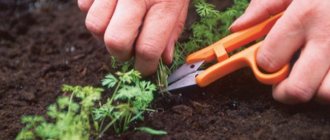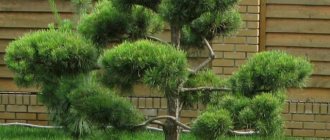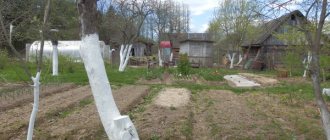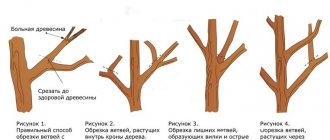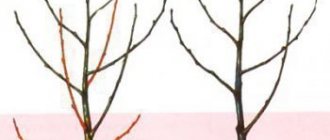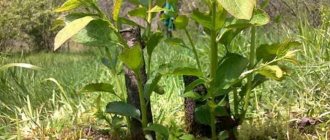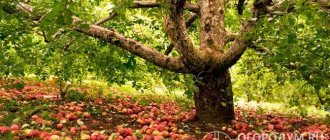A good garden will delight its owner for many years.
But to get such a treasure, you first need to work hard.
At any stage you can make a mistake that will bring all your efforts to naught.
The “wrong” seedling may simply not take root. Taking an apple tree seedling yourself without a clear understanding of how to choose an apple tree seedling is too risky.
In this article we will tell you how to avoid these mistakes and successfully grow an apple tree that will delight you for many years.
Choosing a seedling: how not to make a mistake?
This first step should not be underestimated. It is the choice of seedling that largely determines whether you will be able to grow a healthy tree.
Take this issue seriously:
- Find out which apple tree varieties are suitable for your region . This is very important, because a young tree, unadapted to such a climate, can die long before it begins to bear fruit.
- It is best to contact your local gardening organization or nursery with this question. Their addresses can be found on the Internet.
- Pay attention to customer reviews. Choose a company responsibly.
- The most difficult stage of selection is practical. It all depends on knowledge and attentiveness.
Selection of seedlings in the nursery.
First of all, all seedlings can be divided into three groups depending on the level of the rootstock, i.e. the stem and root system. When choosing one type or another, you need to take into account the characteristics of the site.
There are these types:
- Vigorous - the roots of such trees are deep, they grow up to 7–8 meters, they will feel comfortable if the groundwater is deep (more than 3 meters);
- Semi-dwarf plants usually reach no more than 5 m; for them, a groundwater level of about 2.5 m would be ideal;
- Dwarf ones do not grow more than 2.5 m; these are suitable for areas with close groundwater.
IMPORTANT! If the seedlings have thorns, do not buy it.
Most likely they are passing off a wild apple tree as a varietal apple tree. Contact of the root system with groundwater is extremely undesirable. Such an apple tree will be weak and sickly, its harvest will be extremely meager. When purchasing a seedling, do not forget about the importance of this factor.
The ideal age of a seedling is 1–2 years. The youth of a tree is a guarantee that it will take root better in a new place.
How to visually determine the age of a seedling ? An annual plant should not have developed branches; a two-year-old plant can have 2-3 additional branches.
Inspect the root system. It must not be damaged. Healthy roots are slightly moist, but by no means rotten; they should be elastic, not brittle.
The condition of the cortex is also of great importance. Gently pick off the bark with your fingernail - the stem should be green.
It is better not to buy trees that have leaves . They most likely will not take root.
How much do apple tree seedlings cost?
Saplings with an open root system are cheaper than those sold in a container. The cost of an apple tree seedling depends on the variety and quality of the tree, as well as specifically on the selling company. On average, focus on a price of about 300 rubles, although some nurseries may ask for 800 rubles.
Watch the training video on how to choose the right apple tree seedling:
Classification
Not all of them are harmful to the plant.
There are some mushrooms growing on the apple tree that are in symbiosis with it:
Parasitic
Surely every person has seen fungi on trees, stumps or ordinary dead wood that look like a sponge or resemble a sea shell.
Sponge mushrooms on an apple tree.
Carefully! These are tinder fungi - parasites for our garden and, of course, fruit plants.
There is an opinion that tinder fungi destroy plantings, but this is not entirely the correct conclusion. The bulk of them settle on rotting , old or already dead plants.
But there are those who are not averse to settling on very young trees.
Some of them can remain under the bark for several years and eat the pith and other parts without being detected.
The nature of the lesion depends on the type of parasite . Some of its varieties are quite often found in gardens and homesteads:
- False - produces white core destruction ;
- Plum-red - core and branches ;
- Flat-yellowish-white decay , causing to dry out and become brittle ;
- Real tinder fungus - at the site of rot, usually white or light yellow in color, the core of the wood becomes brittle , stratifies into annual rings;
- Grayish-yellow - rot at the core is brown in color and spreads very quickly through the wood;
- Scaly - forms white rot on the core .
Tinder fungus.
The fungus located on the surface of the wood is not dangerous.
The main danger is in the mycelia, which penetrate deep into the tissues and pose a great danger.
They seem to corrode the wood, forming rot and a hollow, which disrupts the natural physiological process of development. The apple tree weakens and then dies .
Some varieties can destroy a tree in a very short time, while others can suck the juices out of it for decades.
Polypores and the fight against them
You can almost always save a fruit tree if you correctly determine the type and characteristics of the tinder fungus.
Beware of underestimating the consequences it can cause.
The main thing is not to immediately rush into panic and destroy culture.
Usually, up to five years pass from the appearance of the first fungal attacks to a noticeable decrease in yield , so there is time to save the planting from death.
As a last resort, leave such a tree as it is and fight the disease, at the same time plant a new one so that it grows and begins to produce a harvest, becoming, as it were, a replacement for the sick one.
If after annual prevention the fungus appears again , then it is necessary to cut them off and burn .
Advice! Fungal spores are released from the beginning of August , so the procedure for removing them must be carried out before this month.
If there is such a mushroom on an apple tree, what should you do?
Treat cut areas with copper sulfate and garden pitch .
Coat the stamps with casein glue and the addition of karbofos. This will prevent their further occurrence.
Symbiosis with apple tree
There is a friendship between fungal organisms and plants or the so-called symbiosis (mycorrhiza).
This connection between them is very important for both of them.
Entoloma garden apparently enters into symbiosis, since it can often be found under it.
But the relationship has not been fully studied, so it is difficult to say affirmatively about symbiosis in general.
How are apple tree seedlings grown?
Brave gardeners can try growing a seedling themselves . This is not so difficult, especially if you have at least basic knowledge of a school biology course. Let's look at the main methods.
Growing apple tree seedlings from seeds
The first method is growing an apple tree from a seed. Even small children wonder whether an apple tree will grow from an accidentally dropped seed.
In reality, everything is not so simple. There have been cases where a beautiful tree with delicious fruits grew from a seed, but there is a possibility that the grown apple tree will not lose its “mother” properties and all your efforts will be in vain.
But if difficulties and possible risks do not frighten you, follow our advice:
- Rinse mature brown seeds in running water to remove the substance that prevents them from germinating. It is best to place the seeds in water for 3 days .
- Then place the seeds in the refrigerator (this process is called stratification). To do this, you need to prepare a bowl filled with slightly damp sand. The seeds should stay in the refrigerator for about two months. It is best to start stratification in early January .
- The seeds should germinate in the refrigerator. They need to be planted in specially prepared boxes (drainage should be poured at the bottom and a nutrient mixture on top). The boxes should be placed on a well-lit windowsill.
- It is easy to recognize the wildflower even in the early stages: its leaves are bright green, and the shoots already have short spines. It's better not to waste your time on them. Or use the wildflower as a rootstock, to which the desired variety can be grafted.
From a cutting
Apple trees can also be propagated by cuttings.
How to make a seedling from an apple tree branch has been known for a long time. In order to grow a tree in this way, you need to prepare a rootstock - choose a tree grown from a seed or (which is much better) a wild one.
Preparing cuttings for rootstock.
You need to graft a cutting from the tree you want to the roots of such a tree. It is very important to correctly combine the rootstock and cuttings.
For a wild dwarf tree, a cutting of a columnar apple tree is better suited, while an apple tree grown from a seed will take well to a cutting of an ordinary tall tree.
The cuttings must be no older than one year . We will tell you in detail how to make a seedling from an apple tree below.
How to grow apple tree seedlings from a branch
Another way is to bury a branch in the ground .
In autumn, the tree is planted at an angle so that the young shoots touch the ground. In spring, the branches are attached to the bud with staples. During the summer they need to be earthed up, and in the fall ready-made seedlings are obtained.
Air layering or how to get seedlings from an old apple tree
Provide soil with a place where the new root system will form.
It is more difficult to graft a seedling from a branch, so it is often more advisable to use the air layering method.
In order for the branch to begin to take root , you need to surround it with moist soil. To begin, select a twig that will become a seedling - healthy, without branches, and as thick as a regular pencil.
When the snow melts, you need to put a polyethylene sleeve . It is advisable to attach it with electrical tape. It will remain on the apple tree until steadily warm weather arrives. Then the sleeve is removed.
You need to find the boundary between an adult branch and a new growth - from this point you retreat about 10 cm and make a circular cut of about 1 cm, small cuts are also made to the left and right of it. All buds above the incisions must be removed.
Then a sleeve with a container is put on the branch. a liquid stimulating root growth is placed in a container (you can use a cut-off plastic bottle) , then specially prepared soil, which must be constantly kept moist.
You can try any of these methods yourself at home. It is advisable to additionally consult with competent specialists.
Watch a detailed video on how to get a seedling from an apple tree using the air layering method:
Formation of a crown from a top branch
With proper care of the apple tree, spinal branches grow in case of severe damage and are designed to save the dying tree. Therefore, such branches must be left in the following cases:
- if an old tree needs rejuvenation;
- when the central leader freezes out;
- if the top appeared in close proximity to a broken branch;
- when planning the grafting of a new variety.
In this case, in any case, you need to leave only those branches that do not thicken the crown and do not intersect with the skeletal branches.
Formation of a skeletal branch or leader
Formation is carried out using the method of bending and fixing branches. The desired direction is given by hanging weights, installing spacers or tightening. The process is carried out in several stages:
- Pruning branches to 1/3 of their full height. Necessary for further development and emergence of new shoots that form skeletal branches of the second and subsequent orders.
Pruning is carried out above the bud using the following technology:
- the bud under the cut should be directed in such a way that the branch obtained from it is horizontal or grows upward;
- the cut should be made at an angle of 45°;
- the lower edge of the cut should be at the level of the upper side of the kidney;
- the upper part of the cut is 1–1.5 mm above the bud.
In this case, care must be taken not to damage the membrane of the kidney - this will lead to its death. A large stump left above a bud will dry out, causing the branch tissue to weaken and dry out.
- Tops with a diameter of more than 2 cm should be bent in the desired direction gradually to avoid breaking them. To do this, the weight of the load or the length of the spacers should be increased every 10–14 days.
Further annual pruning is carried out in accordance with the general rules for crown formation.
Fruit branch formation
The fruit branch is formed as follows:
- the top should be cut to 2–3 lower buds using the technology of forming a skeletal branch;
- the branches obtained from the remaining buds are growth branches - they form the crown and produce fruiting shoots.
The resulting branches will begin to bear fruit over the next 2–4 years.
Grafting a new variety
Grafting is used to fill voids in the crown or to obtain a fruit-bearing branch of a different variety. This method is the most reliable, since all the power and nutrients are directed specifically to the top. The resulting branches are the most resistant to fungal and viral diseases and produce larger fruits.
Grafting can be done by any known method, but the diameter of the top should be taken into account.
Using a cut top as a scion
The scion taken from a strengthened top branch has a high degree of survival rate. It produces strong skeletal branches, and the resulting fruits have high taste.
How to take seedlings from an apple tree: practical advice
You can take a seedling from an apple tree yourself. You don’t have to be an experienced gardener to do this.
If you want to get a varietal apple tree , then you can use the parent shoot, which sometimes you just need to dig in correctly.
The procedure is carried out in the spring . You can use young shoots no more than 1 year old.
They are placed in a hole about 10 cm deep. The branch is attached to a peg. Thus, a shoot of 30–40 cm should remain above the ground . It needs to be watered regularly and the nearby area must be kept free of weeds.
To be sure, root several branches in this way. In a year, some of them will take root. In the fall, the seedlings will be ready for transplanting.
IMPORTANT! Remember that large-fruited apple trees root worse in this way than other varieties.
If the apple tree doesn't bloom
Beginner gardeners quite often have a question about an apple tree that grows but does not bloom for several years.
The first point that they should pay attention to is the variety of apple tree and the date of its entry into fruiting season. Perhaps the time has not yet come for a particular apple tree to please the gardener with its harvest. As mentioned earlier, apple tree varieties have different fruiting times.
If the time has come for the tree to give birth, but there are no flowers, you need to take the advice of knowledgeable gardeners. In order for the tree to lay flower buds and produce a harvest the following year, you can perform the following operations:
- Bend vertically growing branches and secure them with pegs or spacers at an angle of about 60º relative to the tree trunk.
- Young thin shoots can be secured in the form of a ring.
- Trim off some of the tree's roots.
All these actions will lead to the formation of flower buds, and the next year the tree will produce a harvest.
Pruning an apple tree seedling
Pruning a young tree is an important component of overall tree care.
Do not forget that this is a rather complex process that must be carried out strictly according to agrotechnical instructions .
The seedling needs to be pruned when it is dormant.
In warm climates, the ideal time would be autumn-winter, in moderate climates - the end of winter. In any case, pruning should not be carried out at temperatures below -10°C.
The first pruning takes place in the first year after planting. Pruning at such an early age will ensure the establishment of future skeletal branches.
An annual seedling needs to remove side shoots located up to 70 cm from the ground level. Above this point, only those branches that form an acute angle with the trunk are removed. If the angle formed by the branch with the trunk is close to 90°, the branch is cut to the fifth bud.
A two-year-old seedling looks almost like an adult tree. How to prune such apple tree seedlings? In this case, the following goal is pursued - to leave from 3 to 5 of the strongest shoots, forming a wide angle with the trunk.
In the future they will become the main branches of the tree. It is necessary to form a central conductor . It is best to do this from the most developed bud, which is located about 3 buds higher than the others. The lower branches should be longer than the upper ones. This is how the crown of the tree is formed.
for the next 3–5 years , let it develop on its own.
How to distinguish a pear seedling from an apple tree?
It is sometimes difficult even for experienced gardeners to distinguish different types of trees at such a young age.
Before the leaves appear, this is almost impossible - the seller at the market could experiment with grafting. Let us recall the general rules that will allow you not to become a victim of deception and determine how to choose an apple tree:
- Annual apple trees have dark red-brown shoots, while pears have yellowish-green shoots.
- The shoots of apple trees have slight pubescence; pears usually do not have this feature.
- The shoots of pears have more pronounced geniculation.
- The buds of apple trees are wide and large. They fit tightly to the shoot. Pear buds are pointed and small, and do not fit tightly to the shoot.
- The buds of apple trees swell and bloom later than those of pear trees.
- The root system of apple trees is more branched, while that of pears is stem-like.
There is no need to know about the characteristics of pear and apple tree leaves when purchasing a seedling. If the seedling already has leaves, you should not buy it. It is unlikely to take root successfully, and your efforts will be in vain.
How to grow an apple tree from a seedling?
First, any gardener needs to choose a time to plant an apple tree .
This could be spring or autumn, depending on the specific circumstances and climatic conditions of your region.
In any case, tree care begins in the spring.
Before planting, you need to prepare the soil . This means that the soil needs to be loosened well, rid of weeds, fertilized (depending on the time of year) and dug up again.
The planting hole will be a house for the seedling, it will reliably nourish it.
Choose your location responsibly. This should be a well-lit place, preferably protected from the wind.
IMPORTANT! Preparation of the planting pit should begin 2 months before the actual planting.
The seedling is still too vulnerable. Our task is to protect it from negative weather conditions. The tree needs to be secured to a stake. It will be possible to remove it 2 years after planting. This must be done with extreme caution so as not to damage the root system.
In the first week after planting, regular watering is very important, which will help not only saturate the tree with nutrients, but also compact the soil. Gradually, watering intervals need to be reduced, but in hot weather you cannot spare water for a young tree.
The tree trunk area must be mulched . To do this, use compost, chicken manure, vermicompost and rotted manure; put a small layer of straw on top of this layer.
Watch the video on how to mulch trees:
Be sure to prune one-year and two-year apple trees to form its skeletal branches.
In summer, all care consists of regular watering and protecting the tree from pests. To avoid using chemicals, try attracting birds to your garden .
This is easy to do - arrange feeders on the branches of trees. This will let the birds know that there is a tasty treat waiting for them in your garden.
If pests appear, you can collect them by hand from a young tree. In hot weather, do not water the tree during the day to avoid burns.
To allow air to enter the root system, make 30 cm deep punctures at a distance of 60 cm from the trunk.
Preparing apple tree seedlings for winter.
In the fall you need to prepare the apple tree for winter:
- A young apple tree needs to be hilled to a height of 10–20 cm;
- The area near the trunk must be mulched with humus or peat;
- You can apply nitrogen or potassium fertilizers. The lack of these substances will affect the quality of future fruits, so it is best to use complex fertilizers;
- The trunk of the apple tree must be whitened with a chalk solution;
- To avoid breaking a weak young tree, it can be pre-tied.
Where do apple trees grow?
The apple tree is a deciduous tree of temperate latitudes. In Eurasia, wild apple trees grow throughout the continent. They can be found in European countries located in the far west of the continent, in the Alps, and in the Far East, Mongolia, China, the Caucasus, Central Asia, Turkey, Iran. Wild varieties of this tree also grow in North America, but their fruits are tasteless and small. The ancestor of garden apple trees is considered to be a native of the Old World.
Wild European apple tree
In nature, apple trees can live from fifty to eighty years; in garden conditions, some specimens live for more than a century and even surpass the two-hundred-year mark. In the English county of Nottinghamshire, even today you can see the Bramley apple tree - the Bramley apple tree, which grew from a seed in 1805. Its numerous offspring delight culinary experts around the world with the unsurpassed quality of the fruit.
The Bramley apple tree that grew from a seed in 1805
True, long-lived apple trees are more often found in warmer regions. The further north you go, the shorter the life of the fruit tree. An apple tree in the middle zone lives a maximum of seventy years.
According to the botanical classification, apple trees are one of the genera of the large subfamily Appleaceae in the Rosaceae family, which is part of the infinitely huge order of Rosaceae. That is, apple trees are distantly related to roses, but their closest relatives are quince, pears, hawthorns, rowan trees, cotoneasters, medlars, and serviceberries.
Since ancient times, people began to cultivate the apple tree and develop new varieties and varieties. Now even scientists find it difficult to name the exact number of existing varieties and varieties of apple trees. It is only clear that there are several thousand of them. New varieties are even being developed in Australia, such as the RS103–130 variety presented to the public in 2009.
Australian-bred variety RS103–130
Nowadays, apples are grown on an industrial scale in China, Spain, Germany, Poland, Italy, Canada, USA, South Africa, Argentina, Chile, and New Zealand.
An apple tree seedling is drying up, how to save it?
Before solving the problem, you need to understand its cause , which is why the apple tree may begin to dry out. Then you can understand how to save a dried apple tree seedling.
Trees or shrubs growing too close can interfere with the seedling's development . In this case, you can transplant the tree to the required distance.
Groundwater lying too close can also cause a problem . Excess water simply displaces excess air from the soil, which is so necessary for the young root system. The problem can also be solved by replanting or regularly loosening the soil.
If groundwater is disturbing more than just one apple tree, you can dig drainage ditches that will help get rid of excess water.
IMPORTANT! The key to successful apple tree growth is air access to the root system, so loosen the soil regularly. Do not plant an apple tree in a sandy or clay bud.
Causes of impaired foliage formation in apple trees
A young apple tree seedling may not “wake up” after the first winter if the root collar was buried during planting.
When figuring out why leaves do not develop on an apple tree, you should consider several provoking factors:
- lack or excess of applied fertilizers;
- location of groundwater close to the surface;
- freezing of the root system or freezing of branches in winter;
- pest invasion;
- last year's drought;
- infectious diseases.
Incorrect feeding
It looks like the apple tree was “overfed” with mineral fertilizers.
Some gardeners believe that the better you feed fruit trees, the higher the harvest. This opinion can lead to dire consequences.
The amount of foliage on a tree depends on the presence of nitrogen in the soil, as well as phosphorus and potassium.
The lack of potassium in the apple tree begins to appear on the upper leaves.
A slight lack of nitrogen leads to the fact that the shoots grow poorly, and very few leaves are formed on the branches. A significant nitrogen deficiency can be identified by stunted growth and yellowing of leaves ahead of schedule.
A lot of nitrogen in the soil is dangerous because leaves and branches begin to grow, but very few fruits are formed. Under the influence of nitrogen, apples do not ripen for a long time, have an unusual pale color, quickly fall off and are poorly stored.
A lack of iron in the soil also affects the leaves. The foliage stops growing, turns pale and begins to fall off.
Location of groundwater
High groundwater levels provoke fungal diseases.
The root system of the apple tree does not like too much waterlogging. Groundwater located directly at the level of the roots of the apple tree leads to the fact that the tree begins to disappear.
You can tell that groundwater lies too close to the surface in a garden by looking at certain moisture-loving plants. High soil moisture is favored by coltsfoot, nettle, and horsetail. If these grasses grow under the crown, you can guess that the tree is disappearing due to nearby groundwater.
The location of groundwater close to the surface is indicated by the reddish-ocher color of the soil. This is due to the presence of iron and manganese oxides in the soil.
Infectious diseases
The number of leaves and their size is an indicator of the condition of the apple tree. The degree of foliage may decrease as a result of infection.
- Black cancer occurs on old trees. This disease affects not only the leaves, but also the fruits, as well as the trunks of apple trees;
- Milky shine. When a tree is infected with this disease, the leaves stop growing, become thin, silvery, and then fall off. The ovaries also fall off quickly. When the branches are broken, it turns out that they have turned brown inside and have become very dark on the outside;
- Scab causes spots to appear on foliage and fruit;
- With powdery mildew, a whitish coating appears on the foliage, then the shoots stop growing and the leaves fall off.
Rosette
When rosettes are present, the shoots produce weak growth, and the leaves are hard, brittle, with edges turned up.
Gardeners note rosettes when there is a deficiency of zinc in the soil. Insufficient zinc content is caused by an excess of phosphorus. This can be caused by excessive application of superphosphate or other fertilizer containing phosphorus.
Freezing of the root system
Frost resistance of branches is usually higher than that of roots, so they freeze more often. In spring, small leaves appear on such a tree and there are much fewer of them than there should be.
Frosting of branches
On frozen branches, the bark wrinkles, bursts and dries out.
Severe frosts provoke freezing of annual growth in those varieties of apple trees that are not intended for growing in harsh conditions. Spring warming leads to the fact that the buds on the branches begin to swell, but do not bloom. The tree shows dryness.
If the second half of summer passed with heavy rainfall, fruit trees experience secondary growth. Even if only the buds of apple trees are swollen, the winter hardiness of the tree is greatly reduced. In the spring, it becomes clear how much the tree has suffered from the vagaries of the weather.
Final Tips
Gardening is not only difficult, but also very interesting. To grow a good apple tree from a seedling, you need to show both intelligence and care.
- Remember, the most critical stage is choosing a seedling .
- It is better to buy them from professional breeders. In a spontaneous market, you can unknowingly purchase another tree (an apple tree can easily be confused with a pear tree before the leaves appear).
- In the first year, do not overuse fertilizers . The tree only needs watering and mulching.
- Do not forget to rid the young apple tree of weeds. Fertilizers can be applied in the fall.
- A very important procedure is tree pruning. Remember to do this to form the “skeleton” of the apple tree.
- Pests can negatively affect the development of an apple tree . However, try not to poison them with chemicals in the first years. Involve the birds in this matter .
Attract birds for natural pest control.
- Be responsible about your landing site . Groundwater lying too close and trees and shrubs growing nearby can destroy an apple tree.
- Provide sufficient air access to the root system. She really needs him.
A responsible approach to business will ensure your success.
Features of struggle in different parts of the apple tree
Root
Usually the root is not susceptible to fungal diseases. It affects its bacteria, causing a dangerous disease - root cancer .
Trunk and bark
The main task is complete cleaning of contamination, treatment with copper-containing preparations and protective disinfectant putty.
How to fight fungus in a hollow tree
Hollow in the trunk of an apple tree.
If a large hollow , then experts advise carefully cleaning it with sandpaper, filling it with crushed stone and covering it with cement mortar . Small hollows can be covered with garden varnish.
Methods for propagating apple trees
the vegetative method is mainly used :
- Inoculation;
- Grafting with cuttings;
- Reproduction by layering;
- Rooting cuttings.
Inoculation.
This option helps preserve the original qualities of the parent forms.
Read more about all the methods of propagating apple trees in this section.
The most common varieties
The apple tree is one of the most popular fruit trees in private gardening. The culture is valued for its abundance of varieties that are suitable for almost all regions of the country and its ease of care. About 400 are zoned in Russia, including early, middle, and late. Growing an apple tree and getting a rich harvest is not so difficult if you choose the right variety.
Early (summer)
Mid-season (autumn)
The fruits ripen in September and can be stored for 3–5 months.
- Uspenskoe. Height 3.5 meters, spreading crown. The apples are oval-shaped, yellow-green in color with a red blush. Weight is 180–200 g, but sometimes real giants grow up to 250 g.
- Augusta. Late summer, large tree with a rounded crown. The fruits are also quite large - about 160 g. The shape is oblong. The pulp is juicy, not too dense, coarse-grained, and has a sweet and sour taste. Augusta apples are valued for their high yield, excellent taste and resistance to scab. The removable maturity stage occurs on August 15–20.
Winter
- Antey. Bred by Belarusian breeders. It is characterized by winter hardiness and abundant fruiting. The harvest can be harvested in the third year after planting. The fruits are large - about 250 g, have a round-cone shape. The color of ripe apples is dark red, the taste is sweetish with sourness. The harvested crop can be stored until March.
- Antonovka dessert. Gardeners owe the appearance of the variety to VNIIS named after V.I. Michurin. Breeders crossed the common Antonovka with the saffron pepin. Fruiting occurs 4–5 years after planting the seedling. The yield is about 56 kg, sometimes reaching 140 kg from one tree. The fruits have a greenish-cream color with a slight red blush. Harvesting begins in September, and consumer ripeness occurs in October. Advantages: winter hardiness, good crop keeping quality and high resistance to scab.
Soil preparation
The soil is dug up 2-3 months before planting, while perennial weeds are removed . The event can be rescheduled for the fall. green manure (lupine, beans, clover and others) are planted as nitrogen fertilizers
More on Tele4n.Net:
Grafting apple trees in the fall. Advice from professionals with video on how to properly vaccinate at this time of year
Green manure.
Dense clay soil is dug 2 shovels deep. It is recommended to add for each m²:
- 2 buckets of sand;
- 1 bucket of sawdust;
- 12-15 kg of ready-made humus or compost;
- 0.5 kg fluff lime.
Light sandy soils should be compacted by adding per m²:
- 2-3 buckets of clay;
- 1 bucket of peat, rotted manure;
- 0.5 buckets of ash.
What determines the timing of fruiting?
The timing of fruiting depends on the variety of apple tree, as well as on climate and weather. If everything is clear with the first factor, then the second remains in question.
Unlike any other plants, the apple tree is not a crop that will benefit from excess moisture. The fact is that dry summer days will bring more benefits. The hotter the summer, the faster the growing season of the apple tree will pass. During the rainy season, the tree's roots receive too much moisture, so the growing season slows down significantly.
Gardeners manage to find ways to make the apple tree bear fruit a little earlier, but after planting it still takes time for the tree to begin to bear fruit. Also, the correct choice of variety can contribute to the speedy appearance of apples. There are varieties of fruit trees that have a faster growing season. Among them are the following.
- The “folk” apple tree has medium-sized fruits, which are distinguished by a yellow-golden color, have a rounded shape and a sweet taste with a pleasant sourness and a sugary, spicy aroma. Apples reach maturity in late August - early September, so the variety is considered early ripening. The advantage of this variety is that fruiting begins already in the second year after planting. True, it’s a little sparse, but you can see a few fruits per season. Every year the yield increases.
- The Zhigulevskaya apple tree has very large golden-colored fruits with red splashes on the sides. The apples ripen in September, have a round shape with a flat top and bottom, and their taste is sweet and sour. Such an apple tree begins to bear fruit and bear fruit already in the fourth year after planting. In the eighth year of growth, the crop is characterized by particularly high yields, starting to produce up to twenty kilograms of apples per season.
- The lingonberry apple tree ripens in October and has bright red, elongated fruits. Their weight usually does not exceed one hundred grams. This variety begins to bear fruit in the third year after planting. Also, the advantage of such an apple tree is that it is suitable for cultivation even in areas that are not the most favorable for growing this crop (Yaroslavl, Vladimir, Tver). The variety is frost-resistant, the yield is stable.
The above varieties are the most suitable for cultivation in Russia and surrounding countries. Also no less successful would be the choice of varieties such as “white filling”, “borovinka”, “renet”, “krasa”, “Volzhskaya”, “candy” and others. After planting, such apple trees bear fruit no later than in the fourth year. With proper planting and regular care, the crop may begin to bear fruit a little earlier than usual.
